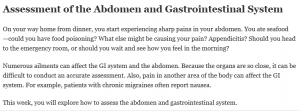Assessment of the Abdomen and Gastrointestinal System

On your way home from dinner, you start experiencing sharp pains in your abdomen. You ate seafood—could you have food poisoning? What else might be causing your pain? Appendicitis? Should you head to the emergency room, or should you wait and see how you feel in the morning?
Numerous ailments can affect the GI system and the abdomen. Because the organs are so close, it can be difficult to conduct an accurate assessment. Also, pain in another area of the body can affect the GI system. For example, patients with chronic migraines often report nausea.
This week, you will explore how to assess the abdomen and gastrointestinal system.
Learning Objectives
Students will:
· Evaluate abnormal abdomen and gastrointestinal findings
· Apply concepts, theories, and principles relating to health assessment techniques and diagnoses for the abdomen and gastrointestinal system
· Analyze chest X-Ray and abdominal X-Ray imaging
· Identify concepts, theories, and principles related to advanced health assessment
Assignment 1: Lab Assignment: Assessing the Abdomen
A male went to the emergency room for severe mid epigastric abdominal pain. He was diagnosed with AAA ; however, as a precaution, the doctor ordered a CTA scan.
Because of a high potential for misdiagnosis, determining the precise cause of abdominal pain can be time consuming and challenging. By analyzing case studies of abnormal abdominal findings, nurses can prepare themselves to better diagnose conditions in the abdomen.
In this Lab Assignment, you will analyze an Episodic note case study that describes abnormal findings in patients seen in a clinical setting. You will consider what history should be collected from the patients as well as which physical exams and diagnostic tests should be conducted. You will also formulate a differential diagnosis with several possible conditions.
To Prepare
Review the Episodic note case study your instructor provides you for this week’s Assignment. Please see the “Course Announcements” section of the classroom for your Episodic note case study.
· Regarding the Episodic note case study provided:
· Review this week’s Learning Resources and consider the insights they provide about the case study.
· Consider what history would be necessary to collect from the patient in the case study.
· Consider what physical exams and diagnostic tests would be appropriate to gather more information about the patient’s condition. How would the results be used to make a diagnosis?
· Identify at least five possible conditions that may be considered in a differential diagnosis for the patient.
The Assignment
1. Analyze the subjective portion of the note. List additional information that should be included in the documentation.
2. Analyze the objective portion of the note. List additional information that should be included in the documentation.
3. Is the assessment supported by the subjective and objective information? Why or why not?
4. What diagnostic tests would be appropriate for this case, and how would the results be used to make a diagnosis?
5. Would you reject/accept the current diagnosis? Why or why not? Identify three possible conditions that may be considered as a differential diagnosis for this patient. Explain your reasoning using at least three different references from current evidence-based literature.
You must address all of the above questions.
ABDOMINAL ASSESSMENT
Subjective:
· CC: “My stomach hurts, I have diarrhea, and nothing seems to help.”
· HPI: KM, 43 yo WF, complains of having generalized abdominal pain that started 3 days ago. She has not taken any medications because she did not know what to take. She states the pain is a 5/10 today but has been as much as 9/10 when it first started. She has been able to eat, with some nausea afterwards.
· PMH: HTN, Diabetes, hx of GI bleed 4 years ago
· Medications: Lisinopril 10mg, Amlodipine 5 mg, Metformin 1000mg, Lantus 10 units qhs
· Allergies: NKDA
· FH: No hx of colon cancer, Father hx DMT2, HTN, Mother hx HTN, Hyperlipidemia, GERD
· Social: Denies tobacco use; occasional etoh, married, 3 children (1 girl, 2 boys)
Objective:
· VS: Temp 99.8; BP 160/86; RR 16; P 92; HT 5’10”; WT 248lbs
· Heart: RRR, no murmurs
· Lungs: CTA, chest wall symmetrical
· Skin: Intact without lesions, no urticaria
· Abd: soft, hyperactive bowel sounds, pos pain in the LLQ
· Diagnostics: None
Assessment:
· Left lower quadrant pain
· Gastroenteritis